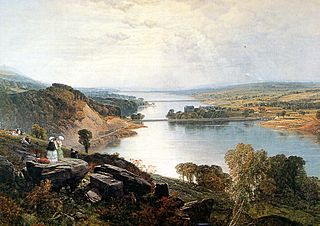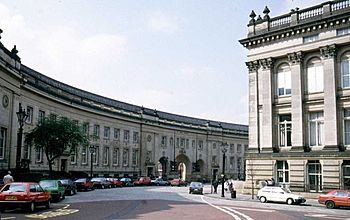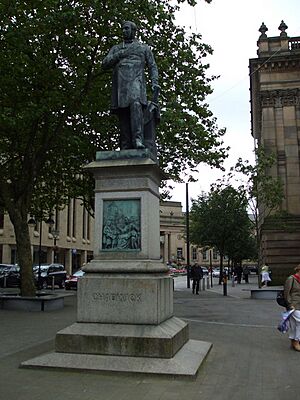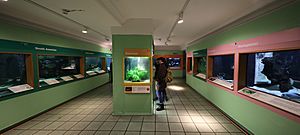- This page was last modified on 17 October 2025, at 10:18. Suggest an edit.
Bolton Art Gallery, Library & Museum facts for kids
The Bolton Art Gallery, Library & Museum is a fantastic place in Bolton, England. It's a public museum, an art gallery, a library, and even has an aquarium! The local council, Bolton Metropolitan Borough Council, owns it.
The museum, often called Bolton Museum, is inside a special building called Le Mans Crescent. This building is very old and important, listed as grade II listed. It's close to Bolton Town Hall. The museum shares its main entrance with the library, which is called Bolton Central Library.
Contents
- Discovering Bolton Museum's History
- The Le Mans Crescent Building
- See also
Discovering Bolton Museum's History
The idea for the museum started way back in 1852. That's when Bolton decided to open its first public library. It was in Victoria Square. At first, there wasn't a museum collection.
The very first items donated were fossils in 1853. Over time, the museum's collections slowly grew. By 1876, it had many scientific items and objects from different cultures. People wanted a separate museum, but the local council didn't want to spend money on it.
How Dr. Chadwick Helped
In 1876, a rich doctor named Samuel Taylor Chadwick made a big difference. He left £5000 in his will to create a museum in Bolton. This generous gift encouraged many others to donate items too.
Dr. Chadwick wanted the money to be used for a 'Museum of Natural History' in Bolton Park. He also said entry should be free for everyone. This early museum was located at Queens Park. It opened in 1884 with three floors of displays.
The Chadwick Museum grew to include important collections. These included textile machines, fabric samples, and ancient Egyptian items. The museum had a clear layout. The basement showed minerals, rocks, and fossils. The ground floor had stuffed animals, birds' nests, and insects. The first floor featured items about people, Egyptology, and other old treasures.
In 1885, the museum received weather instruments. This led to its curator, William Waller Midgley, becoming an expert in weather. The Chadwick Museum was taken down in 1956. Its collections moved to the Le Mans Crescent site.
Other Museum Locations
Mere Hall was given to the town in 1890 to be an art gallery. It mostly showed 19th-century oil paintings. From 1897, the local council started buying art from local artists. In 1938, Mere Hall's art moved to a new gallery at Le Mans Crescent.
Hall i' th' Wood is another historic building. It was given as a museum for Samuel Crompton in 1899. It opened in 1902 after being restored. This museum still serves its original purpose today.
Smithills Hall opened as a museum in 1963. Other smaller museums in Bolton closed later due to budget cuts. Many museum objects are now kept in storage off-site.
The Chadwick Resource Centre opened in 2012. It's a special place where about 60,000 museum objects are stored. It's also a research center.
The Le Mans Crescent Building
The current Le Mans Crescent Museum opened in 1934. It first displayed natural history and art. The aquarium opened in 1941. The museum's full setup was delayed until 1947 because of World War II.
In 2006, a statue called the Amarna Princess was found to be not real. It had been sold to the museum. The museum received £3.8 million in 2018 to make its displays even better.
Amazing Collections to Explore
The museum has many different collections. These include natural history, ancient Egypt, archaeology, art, and local history. It also has one of Britain's oldest public aquariums. All these are housed with Bolton Central Library. The building was designed by local architects, Bradshaw Gass & Hope.
The museum also has two other locations: Smithills Hall and Hall i' th' Wood. The collections include items from many private collectors.
Ancient Worlds: Egyptology, Archaeology & World Cultures
Bolton's archaeological collection is huge, with over 10,000 objects. It's one of the biggest regional collections in the UK.
British Archaeology
The British Archaeology collection has about 4000 items. These come from British sites and include objects from the Neolithic (New Stone Age), Bronze Age, and Roman times. The museum also has local finds from different periods.
Ancient Near East
This collection includes finds from places like British Palestine, Syria, Jordan, Iraq, and Iran. There are also about 3500 ancient textiles from Egypt and Sudan. These fabrics date from around 5000 BC to the 20th century. The museum has animal mummies, shrouds, and bandages.
Worldwide Treasures
The worldwide collection has over 1,500 items. These include objects from Swiss lake dwellings and Aztec material from Mexico. There are also Stone tools from North America, South America, Europe, Africa, India, the Pacific, and Australasia. The museum even has four complete mummified human remains from before Columbus arrived in America.
Egyptology Wonders
The ancient Egyptian objects come from Egypt and Sudan. The collection includes small household items and sculptures. The current Egyptology collection was updated in 2018. It shows how Bolton's cotton trade with Alexandria helped bring these objects to the museum.
The display starts with a golden Egyptian mask. It's set up to look like a Victorian living room, showing how these items were first displayed in the UK. There's also a presentation about how ancient Egypt has influenced art and design today.
Nature's Beauty: Botany and Zoology
The Botany collection has about 60,000 dried plant specimens.
The Vertebrate Zoology collection includes 15,000 to 20,000 specimens. These are birds, mammals, amphibians, reptiles, and fish.
The Invertebrate Zoology collection is even bigger, with about 200,000 specimens. These are animals without backbones, like insects and shells.
Earth's Story: Geology
The geology collection has around 20,000 specimens.
Palaeontology – Fossils
This collection has about 15,000 fossils. Most are British.
Mineralogy
The mineral collection has about 4,000 specimens.
Petrology
The museum's rock collection has 2,000 specimens.
Models
The models collection includes models of prehistoric animals. These were made by the Natural History Museum in London in the 1970s.
Artistic Expressions: Fine Art

Rivington Lakes, by Frederick William Hulme 1872
When the Chadwick Museum started, there wasn't much art. The Mere Hall collection moved to Le Mans Crescent in 1938. Later, much of this collection was sold to make room for new art.
In 1940, Frank Hindley Smith of Bolton left a collection of British and European art to the museum. Bolton received forty paintings, sculptures, and drawings. These included works by important British artists like Vanessa Bell and Duncan Grant.
The gallery now has paintings by artists like J. M. W. Turner and Laura Knight. There are over 1000 prints, mostly by British artists from the 20th century. A famous local painting is "Rivington Lakes" by Frederic William Hulme, painted in 1872.
Sculpture
The sculpture collection has 50 items. Most are British bronze sculptures from the mid-20th century. They include works by famous artists like Henry Moore and Barbara Hepworth.
Decorative Arts
The Decorative Arts collection has 900 British ceramic items, from medieval times to today. It also has 180 glass objects from the 18th century onwards. There are also 20 decorative carved panels by Thomas Kershaw.
A collection focused on Japan was given to the museum in 1959. It includes 150 pieces, mostly 19th-century items like inro and netsuke.
Local History
There is a large local history section with 38,000 objects. These items are from the 17th to 20th century and tell the story of Bolton.
The objects cover many parts of life in Bolton. These include family life, work, business, transport, health, sports, and education.
Special Exhibitions and Stories
Bolton Lives Gallery
The Bolton Lives gallery tells the story of Bolton and its people. It shows how the town has changed over time.
Past Exhibitions: OUTing the Past and Desire, Love, Identity
In March 2019, Bolton Museum hosted the OUTing the Past Festival. This event featured talks about LGBT+ history. It also had performances of "The Adhesion of Love," a play about a visit to Walt Whitman.
In the summer of 2019, the museum hosted the British Museum exhibition "Desire Love Identity." This exhibition told the story of LGBT+ history in the UK. It included special objects and documents from Bolton to show local LGBT+ history. The exhibition also featured "Museum Monologues," which were short plays performed in the gallery.
Talks were given, including one by Matt Cain about his book 'The Madonna of Bolton'. Displays showed the progress of 'Bolton Pride'. They also looked back at local activism and important figures from Bolton's LGBT+ past. These included photos of Bolton's first LGB youth group meeting Anne, Princess Royal.
See also
 In Spanish: Museo de Bolton para niños
In Spanish: Museo de Bolton para niños






